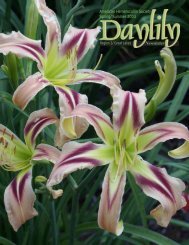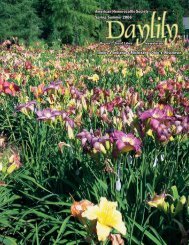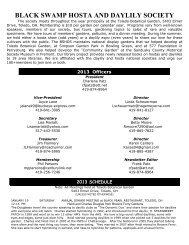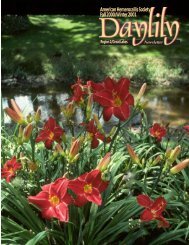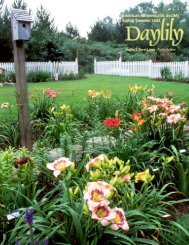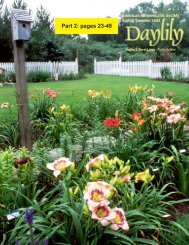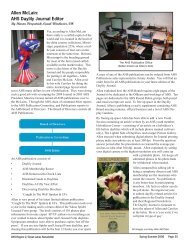Pages - AHS Region 2
Pages - AHS Region 2
Pages - AHS Region 2
Create successful ePaper yourself
Turn your PDF publications into a flip-book with our unique Google optimized e-Paper software.
This and That from <strong>AHS</strong> to <strong>Region</strong> 2 The <strong>Region</strong> 2 Symposium 2005Curt Hanson: Four Seasons of BeautyBy Julie Gridley, Chardon, Ohio“Gardening is the pursuit of spiritual beauty.” With those words, the always-interesting Curt Hanson, organizer, host, and master ofceremonies for the Cleveland Symposium, kicked off the Friday night presentations. His talk led us on a delightful verbal and visual tourof a year of his life, well illustrating his philosophy that “you can find sacredness and magic everywhere you look.”His visual diary began at the end of the daylily season, with ripened seedpods of his hybridizing efforts with daylilies as well as attractiveseedpods of other species. One image that generated many chuckles was a “bounty of fall” composition, which included not only seeds,fruits, and grains, but deer feet! He narrated that slide by saying, “I think we deserve to eat venison, because they eat a lot of our flowers.We should all be eating venison seven days a week; maybe we can get the things under control.” None of the gardeners in the audiencespoke in protest of that sentiment!Our tour moved further into the autumn season with shots of ornamental grasses, colorful witch hazels in their fall foliage, and brilliantJapanese maples, focusing on a few hybrids (such as Acer japonica ‘Waterfall’) that are hardy to zone 5. There were also slides ofinteresting patterns on tree bark, the veined leaves of cyclamens and otherwinter-blooming plants, and shadows on snow. Work in the daylily gardenwas brought to a halt by the arrival of winter, and then our visual tour groupwas invited along on a road trip to the west. Curt admitted that he wasinspired to go traveling, in part, as a response to the outcome of the Novemberelections (though apparently Canada seemed too cold a destination atthat time of year).As he traveled out to California, Curt spent time in the desert southwestand shared stunning images of rock formations, canyons, streams, and mountains.There was an especially impressive shot of a bristlecone pine, one ofthe oldest trees in existence, taken at an altitude of about 9000 feet in deepsnow. The trip west ended near San Diego at the home of Sanford Roberts,the well-known hybridizer who suffered a devastating fire a few years agoand, now in his 80’s, is in the process of rebuilding his home and gardens.Curt spoke highly of this man’s energy and tenacity in the face of the destructionof almost everything he owned. He’s been an inspiration to many.Back home in Ohio, there was evidence of the arrival of spring with imagesof emerging plants such as daffodils, gingers, and mayapples. There was anAsian wildflower, Synelesis palmata, whose sprouting foliage looked like asoft, opening umbrella. (A very interesting genus which is native to Japan,Korea and China. Synelesis palmata: pinkish, excellent foliage, 18", fromJapan, Zone 5 The umbrella-like foliage is deeply cut and very attractive inthe shade garden. It needs a rich, well-drained soil.) There were jack-in-thepulpitswith interesting mottled stems, trilliums with mosaic-like leaves, and anumber of hellebores. Curt discussed the growing popularity of the earlybloominghellebores, the increasing number and variety of hybrids, and howeasy they are to cultivate. His interest in these plants, in fact, has led him tostart spreading pollen and making seeds – and we can only imagine what willhappen to the genus of helleborus now that he’s involved!Not everything he’s tried to grow has responded so well to his greenthumb, however. He had this sage advice for gardeners who are trying plantsthat might be more challenging: “You don’t really know a plant till you’vekilled it a few times, so you keep chasing it around the yard until you findwhere it’s going to be happy.”Above are four images Curt used in his presentation to give usexamples of the Four Seasons of Beauty.From top to bottom (All images: Curt Hanson):• Japanese Maple Acer japonica ‘Waterfall’• Bristlecone pine during winter in California• Synelesis palmata from northeast Asia• Witch Hazel ‘Westerstedt’Visit Curt Hanson’s Crintonic Gardens at:http://www.crintonicgardens.comSomething that doesn’t need any chasing around is the genus of Hamamelis,or witch hazel. Curt highly recommended this shrub for its spring blooms,brilliant fall color, and incredible fragrance. He generously donated a fewpotted witch hazels to the auction so that others could add it to their yardsand suggested that every gardener should grow at least two or three. Aswith the hellebores, they are becoming increasingly popular, and more andmore hybridizers are exploring their genetic potential. There are already over120 registered cultivars.Before the busy gardening season began, Curt took another road trip, thistime to visit some of the Florida hybridizers. His travels took him through theSmoky Mountains, and he shared some beautiful images of the scenery there.After visiting daylily growers in the south, he was inspired to return homeContinued on page 15Page 32 Spring-Summer 2005 <strong>AHS</strong> <strong>Region</strong> 2/Great Lakes Newsletter



